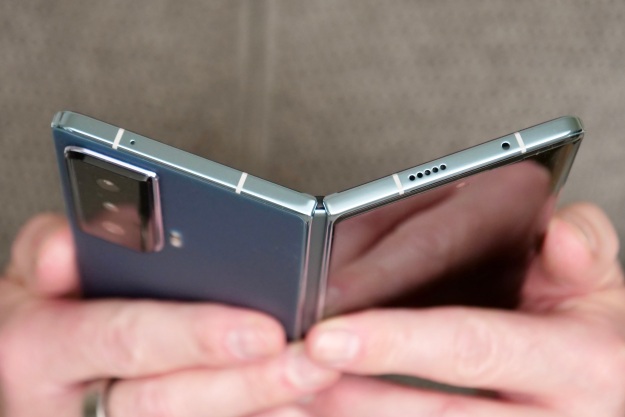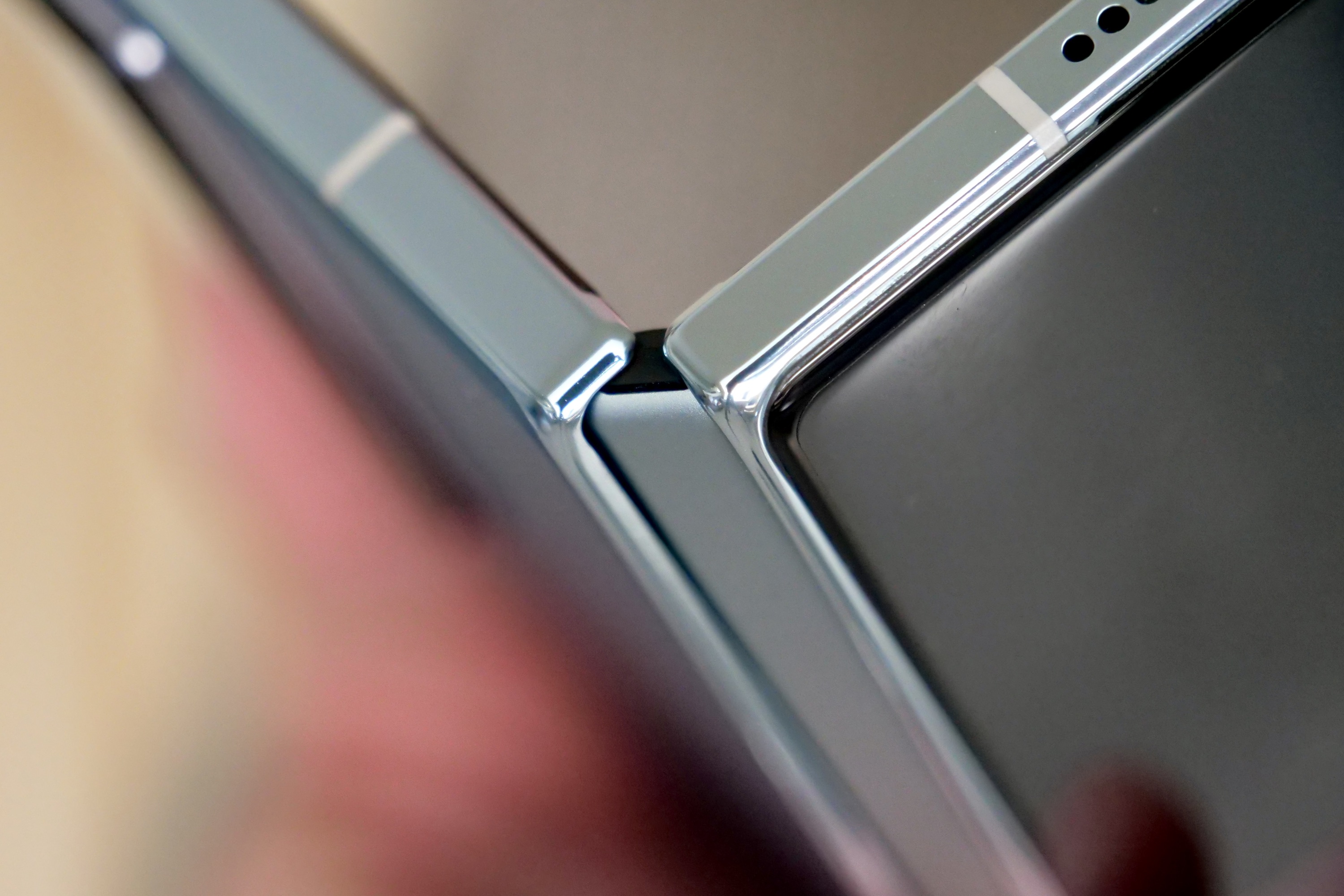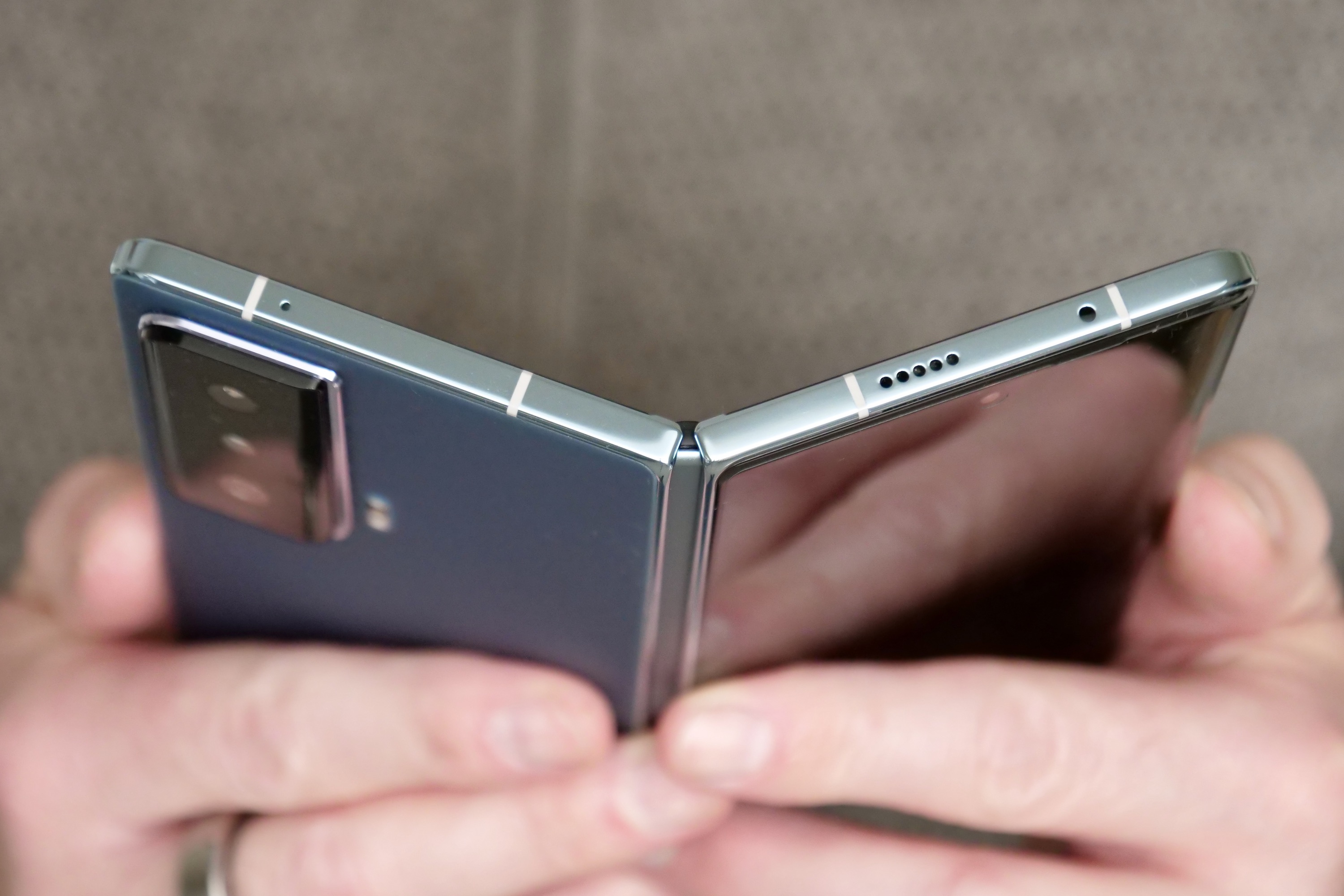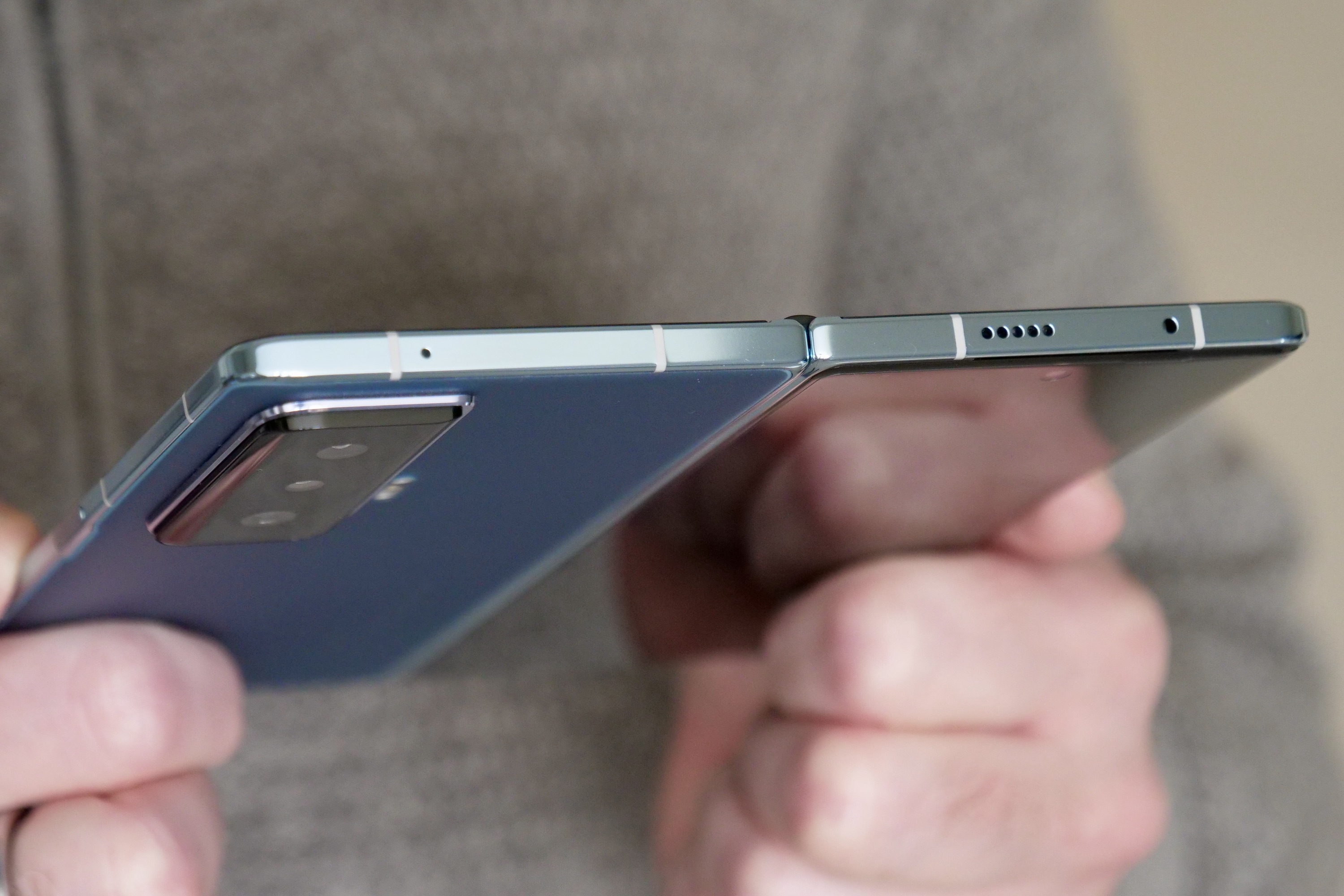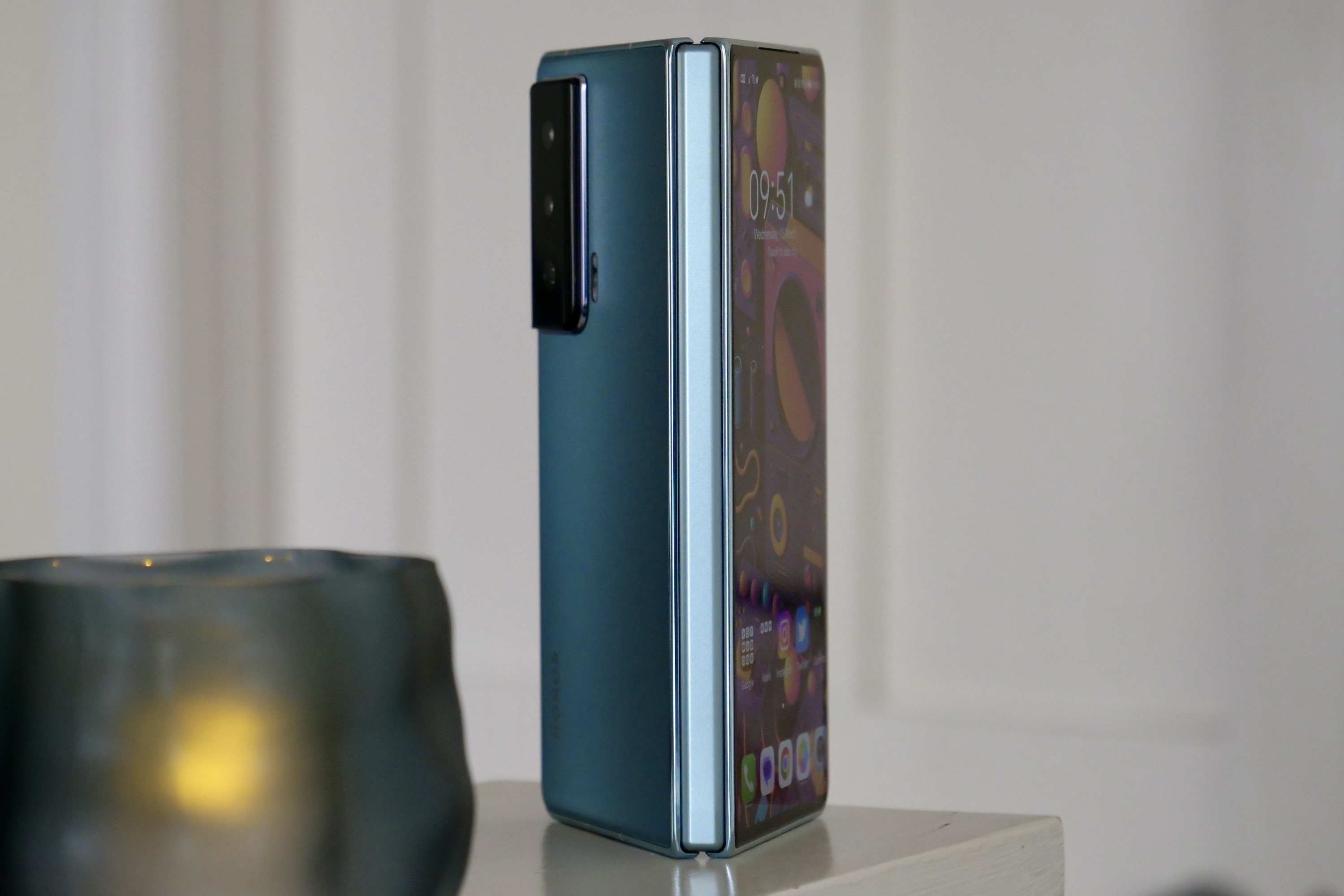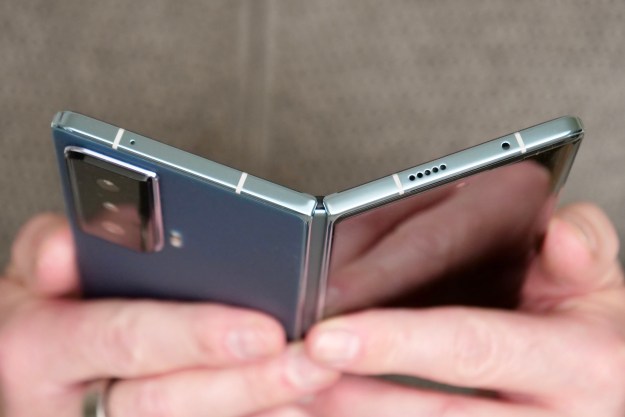
“The Honor Magic Vs has a pretty design and glorious open-screen visuals, but the buggy, disappointing software, poor quality camera, and concerns over durability mean it can’t be recommended.”
- Easy to use when closed
- Two-day battery life
- Big screen is great for video
- Buggy, unrefined software
- Lacks dust resistance
- No wireless charging
- Poor wide-angle camera
We need more big-screen folding smartphones like the Honor Magic Vs to take on the mighty, market-dominating Samsung Galaxy Z Fold 4. But these phones need to do more than just exist
The Galaxy Z Fold 4 is an excellent smartphone, and it’ll take more than just similar hardware to become a serious challenger. Can the Honor Magic Vs steal people away from the Z Fold 4?
Honor Magic Vs: design
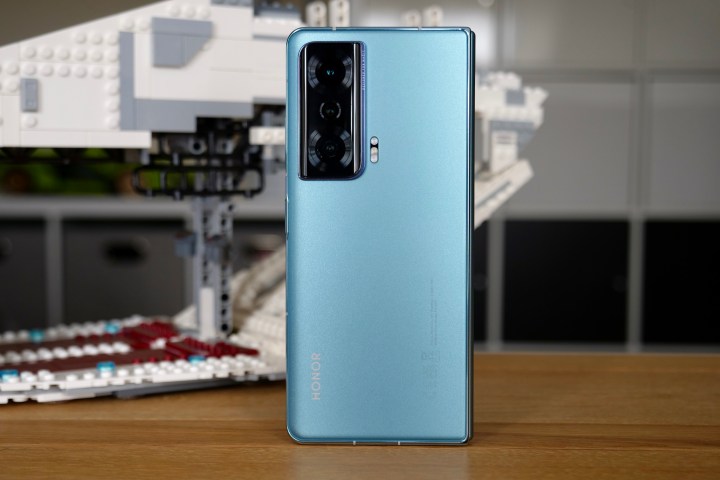
I’m going to talk about the Honor Magic Vs’s design in a mostly positive fashion, but there are a few causes for concern here. The Magic Vs’s wide cover screen is more usable than the Samsung Galaxy Z Fold 4’s, and I’ve primarily used it this way during my weeks with the phone. The keyboard is placed a little low on the screen, which needs adjusting to, but once you have it’s fine. However, it’s Microsoft’s SwiftKey keyboard installed by default, so I installed Google’s Gboard separately, as it’s far more reliable to use.
At 12.9mm thick when closed, the Magic Vs is surprisingly compact, and it has slipped into my pocket without causing a problem. It is quite heavy at 267 grams, and for that reason, you always know it’s there. This also causes fatigue after holding the closed phone for any length of time, but this isn’t a situation unique to the Magic Vs. Open the phone up, and the chassis is 6.1mm thick.
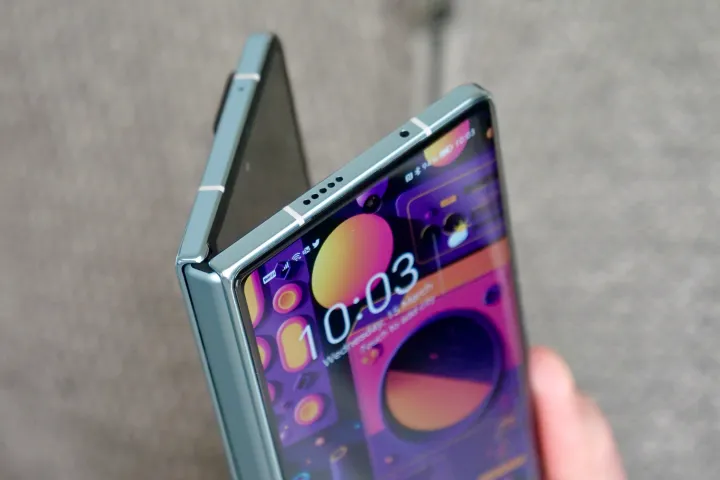
The slimness of the chassis, and the way the phone folds tightly shut without a gap, do make it a little awkward to open. The hinge is still stiff on my review model, and there isn’t much to “grab,” so it takes more effort than I’d like to open the phone. If my hands are sweaty or recently moisturized, then there’s almost no chance of prying the two sections apart at all. I like the gapless construction, but the Oppo Find N2 shares a similar design and isn’t such a pain to open.
The gear-less hinge is quiet, and its special construction allows the phone to close without a gap, but it still seems to be bedding in. At least, I hope it is. Initially, the hinge didn’t have enough resistance to hold it at a semi-open angle, but it seems to be better now after a few weeks of use. However, it needs time to settle after opening it up, as for a start, the phone isn’t quite flat. After a short time, it seems to relax the last few millimeters, which is very strange, and the not-quite-flat angle is really noticeable at first. I’m hoping time will fix it, but I’m not convinced.
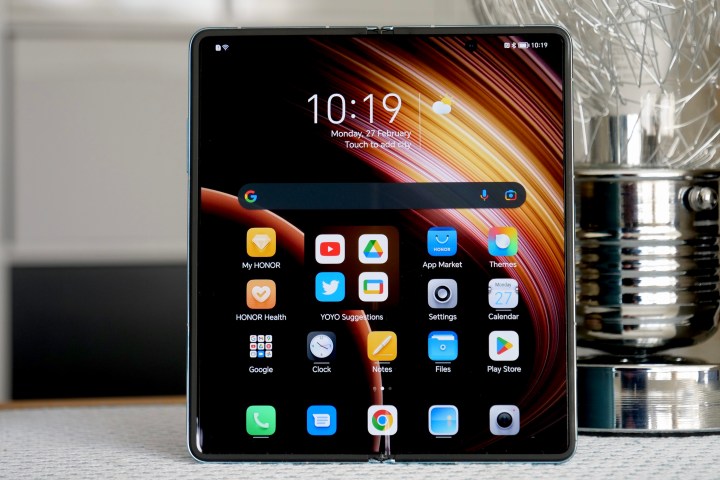
My version of the Honor Magic Vs is in the stunning cyan color, which has a beautiful silver flake inside to really catch the light, but you can also get the phone in an ordinary black color too. The camera module is jewel-like in its shape, with more sweeping corners than you’d expect to find, and it looks great. The Magic Vs has a very attractive overall look, especially in cyan, and the slimness of the chassis makes it feel “normal” in your hand when it’s closed up. I have been able to comfortably use the phone like this, which is great news, but the hinge is not as refined as the one on the Galaxy Z Fold 4.
The hinge isn’t the only issue. The Magic Vs is also lacking any durability enhancements. It does not have a basic IP rating for dust resistance, and there’s no mention of Gorilla Glass or an alternative to give this heavy phone some extra protection in the long term. Honor says the hinge has been tested to 400,000 folds, but outside of this, you should be pretty careful with the Honor Magic Vs if you want it to last.
Honor Magic Vs: screens
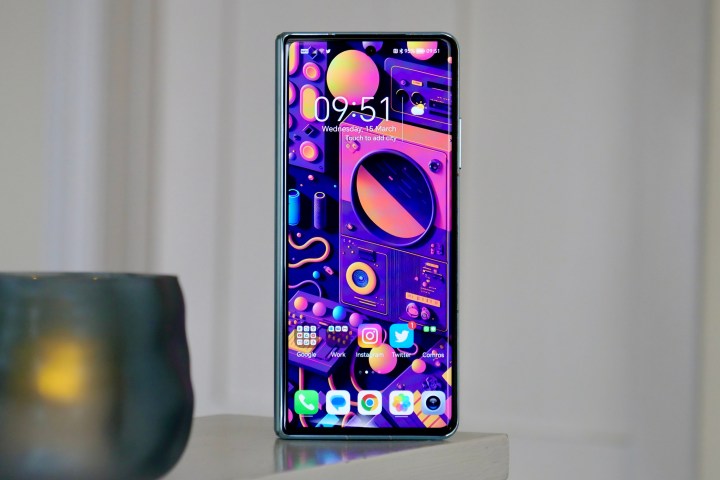
On the outside is a 6.45-inch, 21:9 aspect ratio, OLED screen with a 120Hz refresh rate and a 2560 x 1080 pixel resolution. On the inside is a 7.9-inch OLED with a 10.3:9 aspect ratio, a 90Hz refresh rate, and a 2272 x 1984 pixel resolution. Both have a 90% screen-to-body ratio, 1920Hz PWM dimming for less flicker, a DCI-P3 color gamut, and can show more than one billion colors.
What about a crease? Well, it is there, but as with most foldables you can’t see it when viewed face-on, and when the screen is illuminated. It’s more visible at an angle, and you can feel it when you run your finger across the screen. I don’t find it annoying or distracting, and there aren’t any ripples in the screen on either side. I don’t consider it an issue. Outside visibility is good, but in bright sunlight, there is a lot of reflection on the inner screen.

Both screens have a higher than 60Hz refresh rate, but you won’t always see the 90 or 120Hz refresh rates the screens are capable of. I found that, particularly when closed, the Magic Vs defaults to 60Hz far too often. It’s noticeable in apps like Chrome and Twitter, where blur I don’t expect to see was visible when the refresh rate was left on automatic. I ended up forcing the phone to use the higher refresh rate all the time.
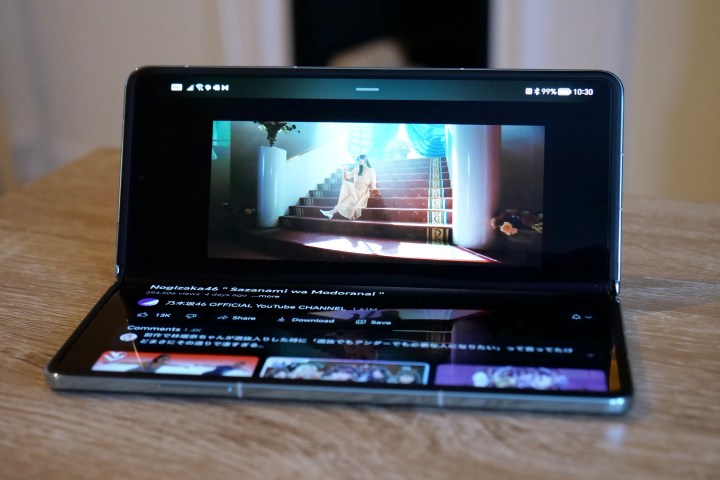
Video looks great, especially on the inner screen, and it remains a huge benefit of big-screen foldables. I love not having to reach for a tablet when I want to really enjoy a video, and the convenience of doing this anywhere is fantastic. It’s the same for reading, whether it’s an e-book or the browser, too.
However, apps (including YouTube) don’t really support the half-angled mode, where the phone supports itself, so the information bar at the top of the screen doesn’t disappear. It also bothers me the volume rocker is on the same side as the camera module, so in this supported orientation, it’s one the leading edge of the phone if you put the phone flat-side down, making it difficult to push.
Honor Magic Vs: software
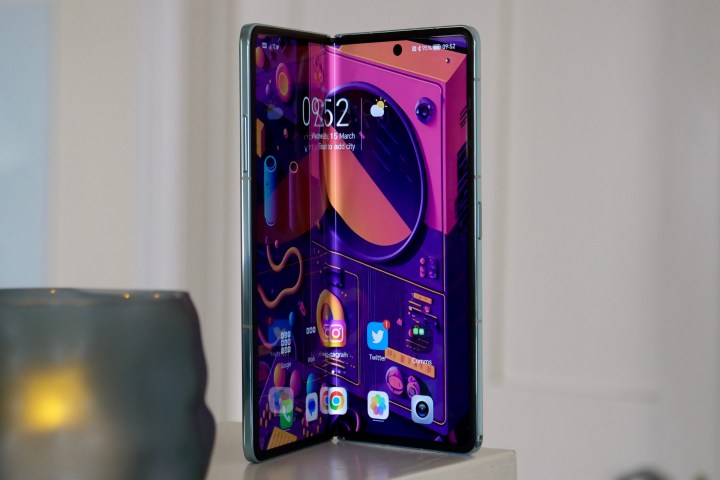
Using the Honor Magic Vs’s software is like stepping back in time by a few years. There are strange design decisions, odd bugs, and a wealth of apps that can’t be uninstalled — making it far less enjoyable to use than One UI on the Galaxy Z Fold 4 and even ColorOS on the Find N2. It’s a real shame, as there are good points about the Magic Vs’s software, but they are outnumbered by the bad.
There’s no app drawer available — a cardinal sin in 2023 for a phone sold outside China. There are at least 22 pre-installed apps, eight of which can’t be uninstalled, and you can only stuff them inside a folder because there’s no app drawer. It makes the phone appear and feel messy. A global search page appears with a swipe down on the screen, but requires a seriously exact bottom-of-the-screen swipe up to make it disappear, which is annoying when you accidentally activate it when trying to use the phone with one hand.
The list goes on, with warnings that apps won’t work when switching between the open and closed screen (but then they work perfectly for no reason), flickering icons using Chrome, and some ponderous animations. When using the camera app with the screen open, the shutter button stays on the right of the screen regardless of the phone’s orientation, but a black bar that can contain buttons for features will shift around the screen, seemingly unattached to those buttons. It all feels unfinished.
On the positive side, apps delivered notifications reliably, and it doesn’t seem to manage power too aggressively. Multi-tasking on the large screen is decent, with the option to show an app on either side of the screen and to add a floating window too. It’s activated using a simple swipe, so it’s not difficult to learn either. I like the unusual “peek” view for certain apps, such as the gallery and the phone, where a small window shows your last action or recent calls.
Honor’s MagicUI 7.1 is reminiscent of Huawei’s EMUI user interface on both Android and HarmonyOS, and it lacks any character of its own. Some of the design decisions mean it won’t appeal to anyone used to Samsung or Google’s Android phone software, and recent usability advancements in Oppo’s ColorOS software mean it lags behind the Find N2 as well. When I first tried the Magic Vs the software wasn’t ready to test, and seeing as this was in November 2022, I had high hopes the months of extra development time meant it would be a real winner on arrival. Unfortunately, it still needs refinement, and, ideally, a design rethink that makes it more appealing to audiences familiar with Samsung and Google’s approach to Android.
Honor says it will deliver three years of major Android software updates, along with five years of security updates too. This is solid but behind Samsung’s slightly longer commitment.
Honor Magic Vs: camera
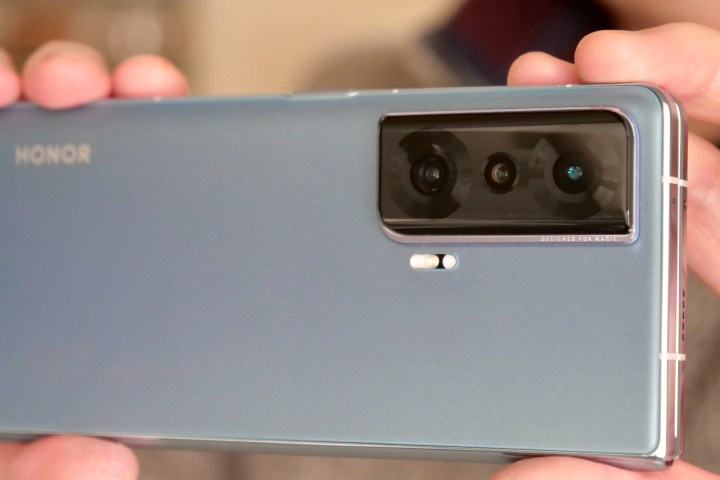
At the top of the camera module is the main 54-megapixel camera, in the middle is an 8MP telephoto camera with a 3x optical zoom and optical image stabilization (OIS), and at the bottom is a 50MP wide-angle camera with a 122-degree field of view, which can also shoot macro photos.
When I previewed the Magic Vs during MWC 2023, I hoped a software update would arrive before I fully reviewed it to fix some of the camera issues, but this has not happened. What it means is the main camera is the only one worth using, as the wide-angle camera is surprisingly poor quality, and the 3x optical zoom’s low pixel count means photos lack detail. The camera app also pushes a 10x digital zoom setting, which is predictably awful.
What’s wrong with the wide-angle camera? There’s a lot of smoothing going on, which robs photos of detail and makes them look artificial and unpleasant. Colors and contrast are not consistent with the main camera, and there’s quite a lot of distortion at the edges of photos too. It’s very disappointing. The 3x optical zoom lacks detail, and like the wide-angle, there’s evidence of smoothing and digital enhancements which don’t change the photos for the better.
The main camera takes pleasing photos with a good balance of colors and contrast, but nothing stands out as being extra special. I’ve come from the Xiaomi 13 Pro, which has a fantastic camera, so the Honor Magic Vs’s generally lackluster performance really showed up. Night mode is passable, but there’s plenty of evidence the software has to step in to maintain quality.
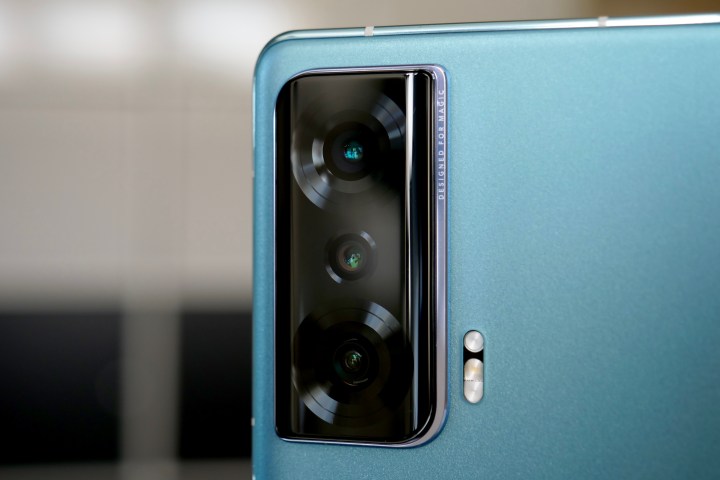
On the video side, Honor has its own version of Samsung’s Single Take mode, called AI Instant, which generates smaller clips and still images from a video, along with a special edit mode to create your own movie. There’s also a special Movie mode with different filters and effects, similar to the system on the Magic4 Pro. The camera can shoot up to 4K resolution at 60 fps.
Some will argue the camera is not the focus here, but this is an expensive, flagship folding phone, and the camera should still be up there with the best. It’s not, and it’ll take some hefty software tweaks to improve it, which I’m disappointed to have not seen yet.
Honor Magic Vs: battery, charging, and performance

The Honor Magic Vs’s 4,900mAh battery has consistently returned two days of average use, which means messages, apps, web browsing, GPS, and taking photos for a total of around three hours per day, with the device turned off overnight. Most days, I end with around 60% battery remaining, so with light use, the Magic Vs’s battery would stretch into a third day.
Recharging the Magic Vs is only possible using a wired connection, as it does not have wireless charging, or a reverse charging feature either. The Honor 66W SuperCharge fast charger is included in the box and offers the fastest way of recharging the battery. Going from 2% (when the phone turned itself off) to 100% takes less than an hour.
Regarding performance, the Honor Magic Vs uses the Qualcomm Snapdragon 8+ Gen 1 processor, with 12GB of RAM, and I have experienced no issues at all. This chip has proven itself to be very efficient in the past, which definitely helps the Magic Vs make the most out of its battery capacity, but there are some concerns when the phone is pushed hard.
I don’t think the software is making the most of its ability. Playing games, including Asphalt 9: Legends, reveals it’s not as smooth or as fast as I expect, and definitely isn’t the faultless gaming experience the Galaxy Z Fold 4 provides. The aspect ratio of the screen means you get bars above and below the gameplay screen too. Playing Asphalt 9: Legends for 30 minutes took 11% of the battery, and watching videos for the same amount of time can take at least 5%.
Additionally, the Snapdragon 8+ Gen 1 has been superseded by Qualcomm, and although it’ll still be a good performer for several years to come, this is a phone with a high price, and for that, I would have liked to see the Snapdragon 8 Gen 2 inside. If you want to keep your new phone for many years, then getting the best specification possible is important.
Finally, calls sound great, and 5G connectivity has been fine too, but I have noticed the Wi-Fi range is short, with the phone failing to pull in a signal where other phones manage to hold on to it.
Honor Magic Vs: price and availability

The Honor Magic Vs has not been officially released in the U.S., and this isn’t expected to change. The phone has been announced for the U.K. and Europe, where it costs 1,399 pounds (around $1,760 U.S. or 1,599 euros). For reference, the Samsung Galaxy Z Fold 4 starts at $1,800, or 1,650 pounds.
Honor will release the Magic Vs on May 19 through Honor’s online store. Additionally, it’ll come to Amazon and retailers like Argos on May 26. There is an interesting launch offer too, where the phone can be yours for 1,199 pounds, which is around $1,500, provided the purchase is complete before May 26. This makes it by far the cheapest big-screen foldable available in the U.K.
It’s good to see Honor keep the price of the Magic Vs well under the Samsung Galaxy Z Fold 4, its primary competitor at the moment, but does that make it worth buying? It definitely makes it more appealing, and the hardware seems even better value, but the camera and software are better on the Z Fold 4 — and spending a little more to get it is still wise. It may also be worth waiting to see the reviews of the Google Pixel Fold and whether it’s the big-screen foldable to beat in 2023.
If you want a folding phone that’s more about convenience, then do take a look at the excellent Galaxy Z Flip 4 and Oppo Find N2 Flip. Alternatively, you can save some money and choose between the two best non-folding flagship phones available today — the Samsung Galaxy S23 Ultra and the Apple iPhone 14 Pro Max. Both have massive screens (admittedly contained in massive bodies), great cameras, and all the power and features you could want. They’ll last you for years.
Unrefined Honor Magic Vs can’t beat the Galaxy Z Fold 4
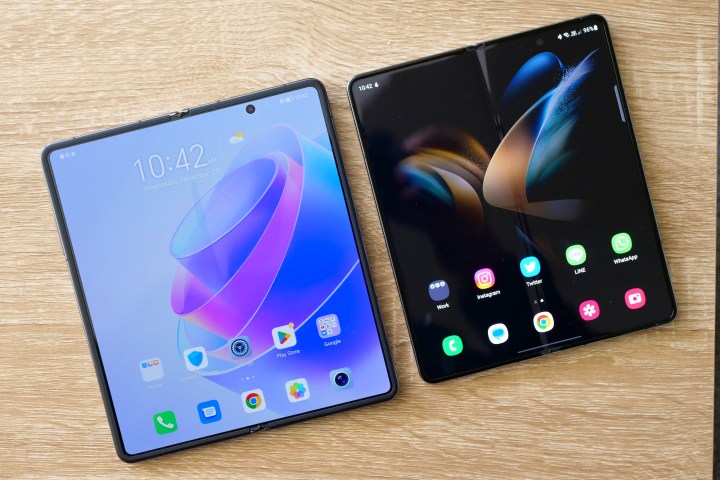
The Honor Magic 4s feels like it has arrived a little too soon, yet I first used the phone in November 2022, so this isn’t a brand new device that has just this moment come to life. Unfortunately, the software feels unfinished, only the main camera takes good photos, the battery life is only decent when you don’t push the phone too hard, and not all apps are optimized for the big screen. The Magic Vs is here, but it probably needed a little more time in the lab.
It’s unfortunate. The hardware is impressive, and the overall design looks excellent. But it’s hard to avoid the lack of dust resistance, wireless charging, and a hinge that doesn’t immediately lay flat. I had high hopes for the Honor Magic Vs when I first tried it, but after using it every day for several weeks, it has not managed to capitalize on this early goodwill.
This isn’t a terrible smartphone, but it suffers from various frustrating problems that see it fall far behind the industry behemoth that is the Galaxy Z Fold 4. The technically “old” processor is unfortunate, too, but you can’t fully dismiss the Magic Vs because of the temptingly low price. A series of software updates may help the Magic Vs in the future, but for now, it’s not quite the big-screen folding smartphone to buy.
Editors’ Recommendations
Services Marketplace – Listings, Bookings & Reviews
